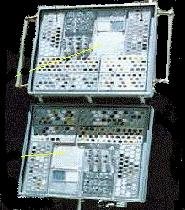 PECsat EXPERIMENT
PECsat EXPERIMENT

Telemetry/Command and Communications Payload
US Naval Academy Satellite Lab
Bob Bruninga, WB4APR
Midn 1/C Patterson
Ensign Sillman
 PECsat EXPERIMENT
PECsat EXPERIMENT

Telemetry/Command and Communications Payload
US Naval Academy Satellite Lab
Bob Bruninga, WB4APR
Midn 1/C Patterson
Ensign Sillman
NEW ITEMS:
PEC: is a Passive Experiment Container used to fly space environment samples to space and back. It is attached to the exterior of the ISS during an EVA to expose its samples to space. The Naval Academy has offered to build a telemetry and command/ communications system similar to what it is flying on the PCsat mission as an opportunity to fly a communications payload in the amateur satellite service and to provide Telemetry to the ground on the progress of the exposed samples to the space environment. The PEC is basically a suitcase for travel that opens in space as shown below (and detailed HERE).
The Telemetry/Command/Communications project would be conducted under the USNA Small Satellite program under the guidance of LTCL Billy Smith and Satellite Lab Senior Engineer, Bob Bruninga, WB4APR. Since it would be flying on the ISS, it would need the concurrence of the ARISS (Amateur Radio on the ISS) international team on the mutual compatiblity of the frequencies used. The proposal is a digipeater uplink on 145.825 MHz and downlink on the 70cm band to avoid any possible interference with existing ARISS missions. It would also include a PSK-31 experiment. Since it has triple redundant transmit inhibits for EVA safety issues, it will also be easy to turn off for an other UHF ARISS experiments that may be launched in the future. Also, the mission lifetime of PECsat is only 1 year.

The PEC Telemetry/Command/Communications
Mission, provides generic UI-Digipeating relay service to help ease the congestion
on the current ARISS Packet radio BBS system (Packet Mail system) and a
linear PSK-31 to FM transponder
for multi-user communications experiments. As an autonomous
payload, it also provides basic Telemetry Command and Control for PEC system and any
other telemetry:

SUMMARY REQUIREMENTS (First Guess):

The TNC COMM system (one of 2) and the dual receivers and dual transmitters.
The digital communications relay will operate within the ITU regulations for educational/outreach operations in the Amateur Satellite Service, to provide simple Satellite digital communications for amateur satellite operators and educators and possible remote environmental sensors worldwide Examples . This comms mission will provide a follow-on extension to the educational communications mission of PCsat, Naval Academy Boats at sea, cross country travelers, expeditions, or other travelers far from existing APRS terrestrial communications infrastructure. The Transponder and PEC data is captured by existing PCsat-to-Internet ground stations and fed into the existing worldwide internet linked APRS system. The PEC mission would join ISS, MIR, PCsat and several other on-orbit experiments (ASTARS) that have been conducted over the years leading up to this exciting capability.
Here are several additional PHOTOS, DRAWINGS and Documents reorganized by topic:
Mechanical details:
Module Details:
The Space segment of the PEC communications mission has been demonstrated a number of times in space via PCsat, MIR School tests, the Shuttle SAREX, and the SPRE mission. . It is also a spin off of a previous launch opportunity that we had in 1998 called NATSweb that almost got launched on SEA-LAUNCH.. The PEC Communications mission is a project to produce a viable payload in a very short time frame using off the shelf components where possible. Here are the background topics of design:
APRS is the Automatic Position Reporting System that the Naval Academy uses for tracking its boats and a variety of other vehicles and networks using the APRS Automatic Position Reporting System . The PEC Communications transponder would be operated under the rules of the Amateur Satellite Service and the rules of the FCC.
You are visitor:
.
|
|
|
|